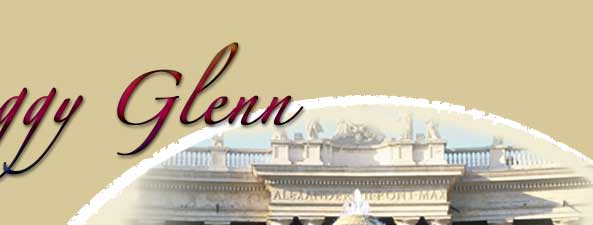|
|
|
Ancient Rome |
|
The Palatine
The beginning of the city of Rome was the Palatine. This area is on a hill overlooking the Colosseum and the Ancient City. Romulus is said to have ploughed the square furrow on April 21, 745 BC. However, there definitely had been people living on the hill before that date.
|
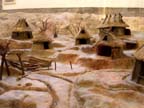 |
The early settlers had lived in early bronze-age huts. There is proof of people from 10,000 BC!
|
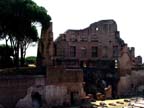 |
During the last 2 centuries BC. many of the who's who of Ancient Rome lived on the Palatine. In 44 BC. Augustus had a home built there. In 28 BC. he inaugurated a temple dedicated to Apollo which he previously ordered built. Pictured is his home.
|
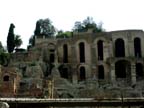 |
Once Augustus moved to the Palatine, almost all the future emperors also went to live there in the house of Augusto. Thus, the first use of the world palace derived from Palatine.
Pictured is Domus Tiberian.
|
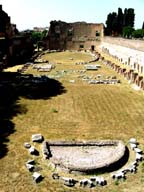 |
Following the great Rome fire of 64 AD. Domitian built a new palace among the ruins. His new palace was a more grandiose structure consisting basically of a public palace and a private residence, a large stadium, and baths. It extended along the slopes of the hill and up to the summit, with halls and stairways, rooms and porticoes, terraces, and fountains. The poet Martial said of the palace, "One of the most beautiful things in the world, a tall and massive pile composed of seven hills placed on top of the other, until they touch the sky." |
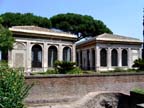 |
It was around 1000 AD that the hill was abandoned and its rich residences became quarries fo materials and the hill fell slowly into ruins.
In 1550 Cardinal Alessandro Farnese bought the Palatine Hill and had a villa built there with a huge garden. Pictured are two of the garden buildings.
|
|
The Ancient City of Rome
called the Forum Romanum
|
|
A couple of unusual facts:
There is a great drainage/sewage system (called the Claoca Maxiun) under the Forum, and it has been there since the end of the 7th century BC. It was originally built to drain the area of all its marshes so the land could be used. This system is still in use for drainage.
|
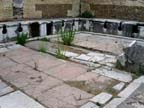 |
As buildings were constructed and people started frequenting the area, public latrines were added that eventually drained into the same system.
I say eventually, because at the same time it became apparent that a great cleaning agent for clothing was human urine. So laundries would soak the clothing first in urine, then later boil the clothing in water with bay leaves to kill the smell. Emperor Titus saw money to be made, and he ordered the urine from the public latrines to be diverted into large vats and sold to the laundries.
|
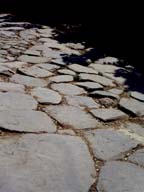 |
The Claoca Maxium made it possible to pave streets, which the Romans were very good at. When the area was excavated in the 1800's, the excavators were sure that the stones they were looking at could not be the original street from the 7th century BC, so when they took up the stones they did not keep track of the order they came out. After they realized their mistake and tried to put the stones back down, they had no idea what the order was. That is why when you walk on the streets today in the Forum the stones are all uneven.
|
|
The history in this area has filled volumes of books, so I will just show you what is left of some of the buildings and give a very brief description. A lot of the buildings were razed in the 14th century for other buildings, St. Peter's being one on the main ones.
There is one major building which is totally gone: Nero's home which he had built after the great fire of 64 AD, (which burned Rome for 9 days) when he confiscated pretty much all the land of the Forum and where the Colosseum now stands. His house was called Domus Aurea (Golden House) it was a large square with a large atrium in the middle. Each side of the house was one mile long! Yes, one mile! Not only that, it was covered in gold, hence the name. It is said that after the completion and the first night he was there he said :"Now I can live like a human." You can imagine that he was not well liked by his people.
|
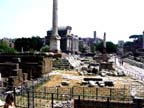 |
Because the buildings are of all ages I will start in the square and will work around in a circle to describe them. Most were used over the centuries for multiple purposes.
Central Area of the Forum: This is where everybody would gather around in the open square. Everybody being politicians, administrators, businessmen and the unemployed or lazy men as some were called.
|
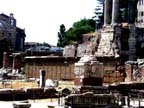 |
At the north end of the central area is the Rostra, which is basically a brick stage area where the great talks were held or speeches given. This is where Marc Anthony made his speech after the assassination of Caesar.
|
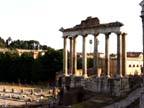 |
In back of the Rostra there are 8 grey granite columns left from the Temple Saturn, originally from 498 BC, but rebuilt in 42 BC and restored in 283 BC after a fire. December 17th every year marks the beginning of a five day party celebrating Saturn. In the ancient days social classes changed places and servants became the masters. Today wild festivities still take place for five days, the last fling before everybody has to straighten up for the celebration of Christmas.
The red brick columns in the background are part of the Basilica Julia.
|
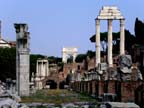 |
The Basilica Julia was the size of a football field (the word basilica is not just used for churches, one definition is: a large oblong building with double colonnades and an apse, used in ancient Rome as a law court or for public assemblies) . The red brick columns are part of the basilica. The building was started by Julius Caesar around 54 BC, it was restored after fires in 9 BC and 283 AD. Many trails were held here and spectators would crowd into the upper balconies. The layabouts would play their gambling games on the front steps.
The 3 white columns in the right corner is the Temple of Castor and Pollux from 484 BC
The Arch of Titus is in the center background..
|
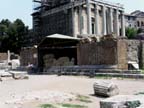 |
The Temple of Divus Julius is in the middle of the Forum. After Julius Caesar’s death on the Ides of March in 44 BC, his adopted son, Octavian, had his father honored as if he were a god by dedicating this temple to him.
|
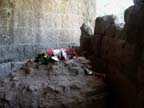 |
As you can see, Caesar's followers still leave flowers on the temple in honor of him.
|
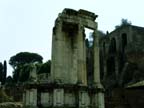 |
The Temple of Vesta is very old. The original building date is not known, only that it was rebuilt after a fire in 191 AD. Vesta is one of the goddesses dearest to the Roman people. She is the goddess who protected the domestic hearth, which is why the round shape, after the round shape of the ancient Roman huts. A sacred fire was kept constantly burning inside to stop terrible misfortune from striking the city of Rome. This caused a lot of fires which destroyed the temple many times.
|
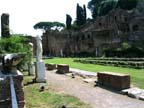 |
The House of the Vestals is where the virgins lived. It was a great honor to be chosen as one of six Vestal Virgins at a young age of around seven. They were given the status of Priestess and were in charge of guarding the fire in the Temple of Vesta. They remained as Vestal Virgins for thirty years (or unless they broke the rules) and they received a very nice income from the state in addition to a great place to live. If a condemned man happened to cross their path, his death sentence would be lifted and he became a free man. The rules were very strict, if a virgin let the fire go out, or no longer was a virgin, she would be buried alive (with a loaf of bread and a lamp) in a small underground chamber in the "field of the wicked." |
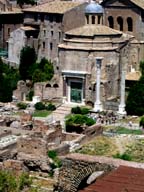 |
The Temple of Romulus is interesting in that it was built around 300 BC and has very large bronze doors with a lock that still locks! When it was excavated around 1970, the key was found and sure enough, it fits into the lock and still works. The church has possession of the key today. It is thought that the temple was dedicated to Jupiter Stator and the Household Gods. Together with Vesta, the Household Gods protected home and family.
|
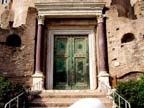 |
The columns on either side of the door are made from Porphyry marble. This marble now costs $5,000 per square inch! The reason why is that when the Roman's first invaded Egypt they were amazed by this red marble and mined every bit of it! There is none left to mine anywhere in the world. Most of it was used to decorate ancient Rome, including the Colosseum. Then in the 14th century when the great St. Peter's was being built almost all of it ended up there. There is some in St. Paul's and in the floor of the Pantheon.
|
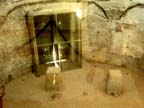 |
The large building directly behind the Temple of Romulus is a church named Basilica St Cosmos Daminao, which is still in use today. The basilica was built right up to the temple. The temple was used as an atrium for the basilica in the 18th and 19th century until excavation of the Forum started. In the 1970's the church and the Office of the Superintendent of Archeology of Rome decided to excavate the inside of the temple. After almost two centuries, the floor of the temple was now filled with silt and was paved to the height of the floor of the basilica, which is about 30 feet higher than the original floor. You can see the inside of the doors in this picture.
|
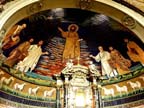 |
The basilica was completed in 525 AD. It took three years to complete this mosaic 527 to 530 AD.
|
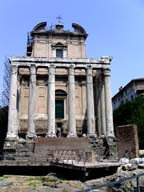 |
The Temple of Antoninus and Faustina started as a temple in honor of Antoninus's wife of three years Faustina, who died in 141 BC. When Antoninus later died, the Senate added his name to the temple.
Look at how high up the green door is. This is shows how much the ground level had risen by the 12th century when the building was used as a church..
|
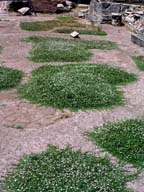 |
In 1902 archaeologists discovered part of the Forum burial ground. The tombs date back to the Iron Age, about 3,000 years ago! The only reminder today are the flower beds over the area where each tomb was found.
|
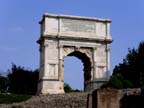 |
The Romans built triumphal arches to celebrate their victories. There are three arches in the Forum area:
Arch of Titus erected in 80 AD to celebrate the 71 AD conquering of Jerusalem, the holy city of the Jews. In this battle the temple of the Jews was completely destroyed and looted of all its valuable artifacts including the seven branch candelabra and the silver trumpets. These artifacts are barely visible in the relief located in the middle section of the arch depicting Tutus parading them, and the rest of his booty, through the streets of Rome.
|
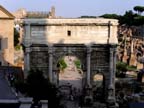 |
Arch of Septimius Severus erected in 203 AD to celebrate the victory over the Parthians and the consequent expansion of the Roman Empire.
|
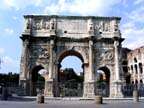 |
Arch of Constantine erected under the orders of the Senate in 315 AD after his victory over Maxentius on October 28, 312 AD. It contains statues and reliefs taken from the most ancient buildings. This was done because most of the sculptors and artisans had already moved to the new capital of the Roman empire, Constantinople.
|
|
Again, this is a very brief description of the Forum area. There are many buildings that I have not included due to limited space.
|
|
|
|
|
|
|
|
|
|
|

